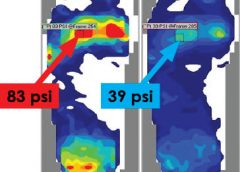Guidelines for managing prosthetic joint infections released
The Infectious Diseases Society of America has released guidelines for diagnosing and managing prosthetic joint infections.
“Diagnosis and management of prosthetic joint infection: Clinical practice guidelines by the Infectious Diseases Society of America,” published in Clinical Infectious Diseases, notes that of the 1 million people each year who have their hips or knees replaced, as many as 20,000 will get an infection in the new joint.
The guidelines describe the best methods for diagnosing these infections, which are not easy to identify. Specifically, infection should be suspected in a patient who has any of the following: persistent wound drainage in the skin over the joint replacement, sudden onset of a painful prosthesis, or ongoing pain after the prosthesis has been implanted, especially if there had been no pain for several years or if there is a history of prior wound healing problems or infections.
Guidelines for treating infections are included and note that 4 to 6 weeks of I.V. or highly bioavailable oral antibiotic therapy is almost always necessary to treat prosthetic joint infections.
A decade of TIME
The TIME acronym (tissue, infection/inflammation, moisture balance, and edge of wound) was first developed more than 10 years ago to provide a framework for a structured approach to wound bed preparation and a basis for optimizing the management of open chronic wounds healing by secondary intention. To mark the event, the International Wound Journal has published “Extending the TIME concept: What have we learned in the past 10 years?”
The review points out four key developments:
• recognition of the importance of biofilms (and the need for a simple diagnostic)
• use of negative-pressure wound therapy
• evolution of topical antiseptic therapy as dressings and for wound lavage (notably, silver and polyhexamethylene biguanide)
• expanded insight into the role of molecular biological processes in chronic wounds (with emerging diagnostics).
The authors conclude, “The TIME principle remains relevant 10 years on, with continuing important developments that incorporate new evidence for wound care.”
Bed alarms fail to reduce patient falls
A study in Annals of Internal Medicine found that the use of bed alarms had no statistical or clinical effect on falls in an urban community hospital.
The 18-month trial included 16 nursing units and 27,672 inpatients. There was no difference in fall rates per 1,000 patient-days, the number of patients who fell, or the number of patients physically restrained on units using bed alarms, compared with control units.
Authors of “Effects of an intervention to increase bed alarm use to prevent falls in hospitalized patients: A cluster randomized trial” speculate the lack of response may be related to “alarm fatigue.”
Drug for HIV might help in Staph infections
A study in Nature reports that the drug maraviroc, used to treat HIV, might be useful for treating Staphylococcus aureus infections.
“CCR5 is a receptor for Staphylococcus aureus leukotoxin ED” found that the CCR5 receptor, which dots the surface of immune T cells, macrophages, and dendritic cells, is critical to the ability of certain strains of Staph to specifically target and kill cells with CCR5, which orchestrate an immune response against the bacteria. One of the toxins the bacterium releases, called LukED, latches on to CCR5 and subsequently punches holes through the membrane of immune cells, causing them to rapidly die.
When researchers treated cells with CCR5 with maraviroc and exposed the cells to the Staph toxin, they found maraviroc blocked toxic effects.
Dog able to sniff out C. difficile
A 2-year-old beagle trained to identify the smell of Clostridium difficile was 100% successful in identifying the bacteria in stool samples, and correctly identified 25 of 30 cases of patients with C. difficile, according to a study in BMJ.
“Using a dog’s superior olfactory sensitivity to identify Clostridium difficile in stools and patients: Proof of principle study” discusses how the dog was trained to detect C. difficile and concludes that although more research is needed, dogs have the potential for screening for C. difficile infection.
After-hours access to providers reduces ED use
Patients who have access to their primary healthcare providers after hours use emergency departments (EDs) less frequently, according to a study in Health Affairs.
“After-hours access to primary care practices linked with lower emergency department use and less unmet medical need” found that 30.4% of patients with after-hours access to their primary care providers reported ED use, compared with 37.7% of those without this access. In addition, those with after-hours access had lower rates of unmet needs (6.1% compared to 12.7%).
The findings come from the 2010 Health Tracking Household Survey of the Center for Studying Health System Change. The total sample included 9,577 respondents.
Neuropathic pain in patients with DPN might contribute to risk of falling
The presence of neuropathic pain in patients with diabetic peripheral neuropathy (DPN) contributes to gait variability, which could in turn contribute to the risk of falling, according to “Increased gait variability in diabetes mellitus patients with neuropathic pain.”
The study, published in the Journal of Diabetes and Its Complications, compared patients with at least moderate neuropathic pain with those who had no pain. Researchers used a portable device to measure gait parameters, such as step length and step velocity.
Amputation rates decrease significantly in patients with PAD
“Temporal trends and geographic variation of lower-extremity amputation in patients with peripheral artery disease (PAD): Results from U.S. Medicare 2000–2008” found that amputation rates have decreased significantly, but that significant patient and geographic variations remain.
The study, published in the Journal of the American College of Cardiology, found that among 2,730,742 older patients with identified PAD, the overall rate of lower extremity amputation decreased from 7,258 per 100,000 patients to 5,790 per 100,000. Predictors of lower-extremity amputation included male sex, black race, diabetes mellitus, and renal disease.



